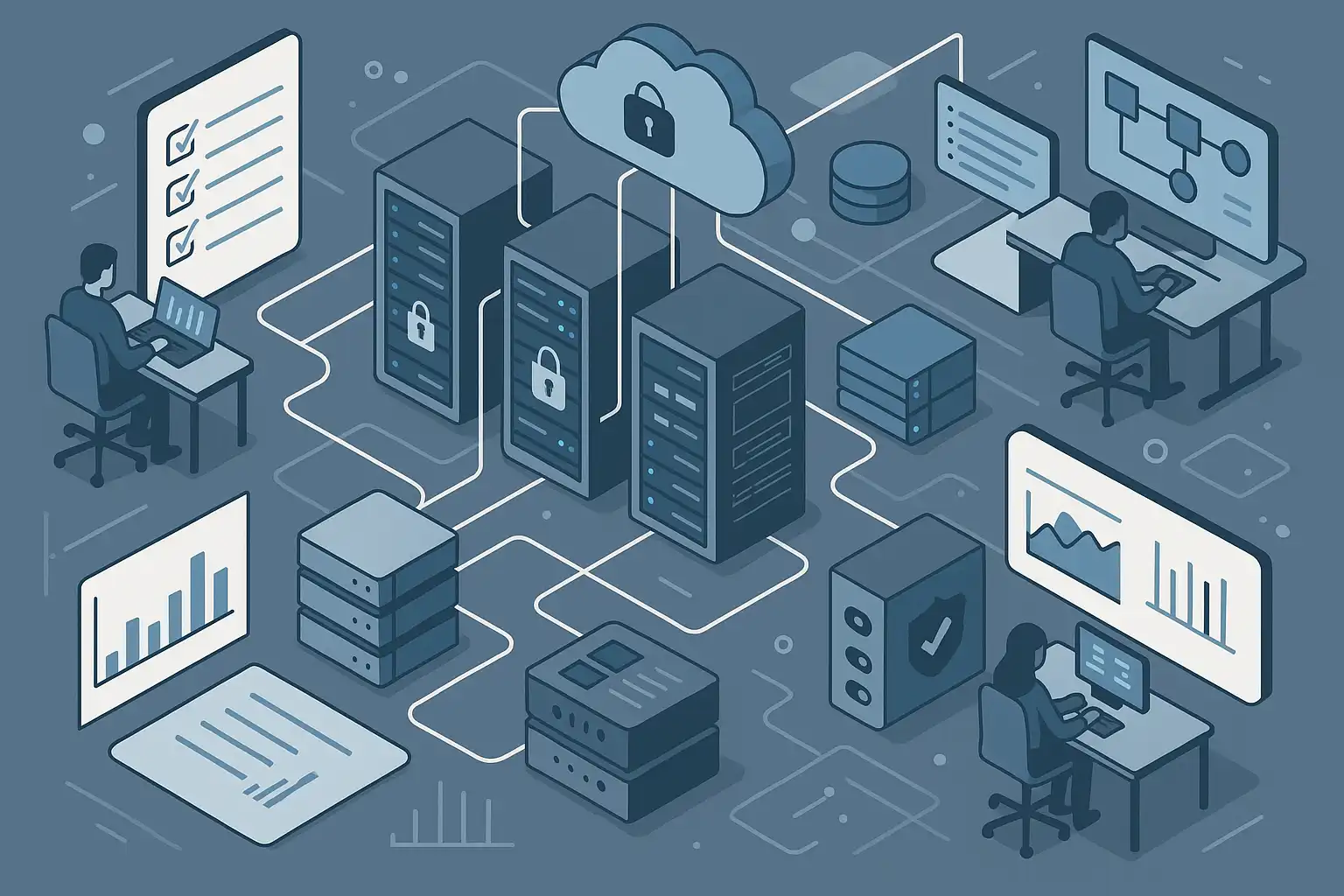
If your organization handles any kind of data—personal, financial, operational—then a strong data governance strategy and roadmap is essential for compliance and building trust. From the start, you need a clear plan: define who is responsible for data, set up the right processes, and use technology to protect sensitive information. By doing so, you not only meet legal and regulatory requirements, but also create a foundation of trust with customers, partners, and staff. In this guide, you’ll learn exactly what goes into a successful data governance strategy and roadmap, why it matters, and the steps to make it work in real life.
What are the essential components of a data governance strategy and roadmap?
At its core, a data governance strategy and roadmap is a set of actionable plans and policies that guide how your organization handles data. Key components include:
- Operating Model: Link data projects directly to business goals. This means every data initiative—like improving customer insights—should have clear owners and measurable results.
- Roles and Responsibilities: Use frameworks such as DACI (Driver, Approver, Contributor, Informed) or RACI (Responsible, Accountable, Consulted, Informed) to clarify who does what. This helps avoid overlap or missed tasks.
- Skills and Funding: Assess team expertise and secure funding. Often, compliance-driven projects can provide the initial momentum and resources you need.
- Process Phases: Build clear steps from data discovery (finding where data resides), to defining data (setting rules), applying governance controls, and monitoring for ongoing compliance.
- Modular Technology: Choose solutions that are flexible and can grow with your needs. Cloud-based and microservices tools offer adaptability and scalability for future challenges.
- Centralized Metadata Management: Manage data’s details—like where it comes from and who can see it—from a central governance console to keep things consistent and secure.
- Automation and AI: Use automation to discover, catalog, and protect data. AI helps detect risks and enforce protection policies more efficiently.
- Stakeholder Engagement: Secure executive sponsorship and foster close communication between business and IT teams. Regular updates and collaboration increase buy-in across the organization.
- Data Literacy: Train staff at all levels to understand and use data properly. This builds confidence and supports better decision-making over time.
How do you ensure regulatory compliance with a data governance roadmap?
To meet today’s strict data protection laws, organizations must align their data governance strategy and roadmap with specific compliance requirements. Here’s how you can do that:
- Start with Regulations: Identify the laws—such as GDPR, HIPAA, or CCPA—that apply to your data. Understand exactly what each requires, from consent to record-keeping.
- Set Priorities Based on Risk: Focus first on projects that address your biggest compliance gaps or those that will produce the fastest benefits. For example, securing personal data or ensuring data access logs are in place.
- Assign Clear Ownership: Designate accountable parties for each compliance-related activity. Document roles and communicate them widely.
- Leverage Technology: Use modern, modular, and cloud-based governance platforms to enforce policies, track access, and automate monitoring. Many leading tools support features like automated discovery, real-time alerts, and audit-ready reporting.
- Centralize Control: Pull all your data rules, metadata, and controls into a single platform. This centralization enables rapid response to audits and ensures consistency.
- Measure and Report: Track compliance through dashboards and KPIs—such as how quickly incidents are identified and resolved. Regular reporting gives stakeholders and regulators confidence that controls work.
- Review Frequently: Update your processes as laws evolve and as you add new data types or systems. Continuous improvement is essential for staying compliant over time.
Real-world example: Compliance funding as a springboard
Many organizations use compliance projects as a catalyst to launch broader data governance. For example, implementing a solution to satisfy GDPR data subject requests can also be used to standardize data definitions for the marketing department. By showing quick wins and leveraging compliance budgets, teams can build a long-term governance foundation. This approach also helps in estimating outsourcing data management cost quality and identifying potential areas for optimization, ensuring resources are allocated wisely.

How does a data governance strategy and roadmap build organizational trust?
Trust is earned by delivering reliable, secure, and transparent data practices. A strong data governance strategy and roadmap helps in several ways:
- Executive Sponsorship: When leaders actively support data governance and communicate its value, it signals commitment to customers and employees alike.
- Consistent Communication: Regular updates on policies, roles, and results reduce confusion and foster a sense of shared purpose.
- Cross-Functional Teams: Involving both technical and business units ensures a holistic approach. It breaks down silos and increases shared ownership of data responsibilities.
- Reliable Processes: Documented and repeatable steps for data handling, quality, and access demonstrate reliability to stakeholders.
- Transparent Technology: Using platforms that log every access and change to data makes it easy to prove compliance and earn trust.
- Education and Literacy: Ongoing training builds confidence in data understanding and usage, reducing mistakes and improving data-driven outcomes.
- Continuous Feedback: Gathering input from all sides—executives, IT, and business users—ensures the strategy stays relevant and effective.
Best practices to enhance trust through data governance
- Secure leadership buy-in from the outset and maintain their visible commitment.
- Communicate the business value of governance clearly, showing how it supports strategic goals.
- Build teams that combine IT, legal, and business skills for broad perspective.
- Adopt technology that grows with your organization, supports automation, and provides clear records of activity.
- Standardize how data is defined, catalogued, and controlled for consistency.
- Measure progress with business-aligned metrics like improved customer satisfaction or faster regulatory audits.
For instance, aligning your governance plan with overall business priorities is crucial—a topic closely connected to data strategy alignment with business goals, which ensures that technology decisions actively support growth and stakeholder needs.
What steps can organizations take to implement a successful data governance strategy and roadmap?
To put your strategy into action, follow these practical steps:
- Assess Your Current State: Review existing data processes, identify gaps, and document risks.
- Define Goals and Scope: Set realistic objectives based on compliance requirements, business needs, and available resources.
- Build a Governance Team: Assign champions, clarify roles, and engage stakeholders early.
- Map Out Processes: Design structured workflows for managing data—from collection to deletion. Include controls for quality, access, and retention.
- Choose the Right Technology: Look for modular, scalable solutions that integrate with existing systems and support automation.
- Educate and Train: Promote data literacy through workshops, guides, and ongoing support.
- Monitor and Improve: Continuously review outcomes, update policies, and adapt to evolving business and regulatory landscapes.
Which tools and brands support data governance?
Many organizations rely on established tools for governance. Vendors like Collibra, Informatica, Alation, and Microsoft Purview offer robust data governance platforms. These solutions typically support centralized metadata management, policy automation, role-based access, and audit-ready reporting. Cloud providers such as AWS, Azure, and Google Cloud also offer built-in governance features for hybrid and global organizations. Automation and AI capabilities—such as machine learning-based discovery and privacy risk detection—can be layered on top to scale governance efficiently.

FAQ
- What is the main purpose of a data governance strategy and roadmap?
- The main goal is to ensure data is managed responsibly, meeting compliance rules while enabling trusted, data-driven decisions. It provides clarity about who owns what, sets up robust processes, and uses technology to keep data accurate and secure.
- How often should we review or update our data governance roadmap?
- It’s wise to review your roadmap at least once a year, or whenever there are major changes to business priorities, regulations, or technology. Continuous improvement helps you stay ahead of risks and shifting compliance demands.
- Can smaller organizations benefit from a data governance strategy and roadmap?
- Absolutely. Strong governance is not just for large companies. Any organization that collects and uses data can benefit by improving trust, reducing risks, and supporting growth—even with limited resources.
- Is automation necessary in data governance?
- While not mandatory, automation can significantly reduce manual effort, prevent errors, and scale governance as your data grows. Automated discovery, cataloging, and protection make it much easier to maintain compliance and control.
